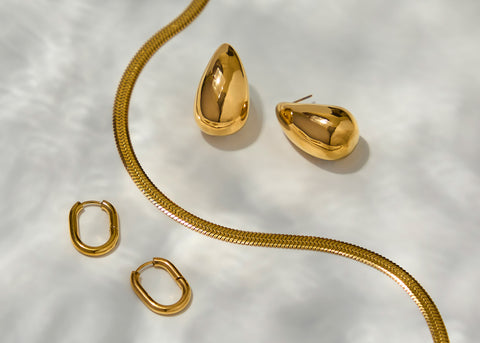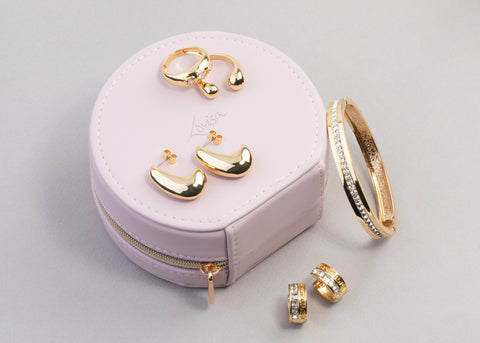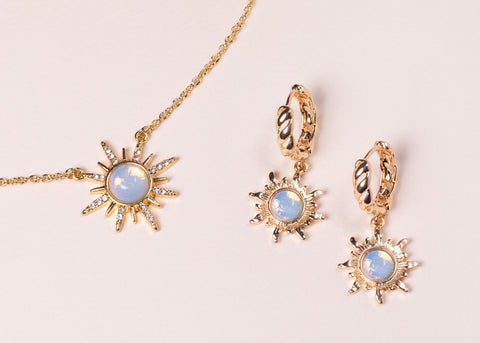May 01 2024
Guide to Waterproof Jewelry
Guide to Waterproof Jewelry - Facts & Care Tips

If (like us), you’re guilty of wearing your jewelry in the shower, to the beach or even at the gym – you might be on the hunt for jewelry that can keep up with your routine. In this guide, we’re covering the basics of everyday jewelry – and the best options that will stay shiny and new for years to come.
What Makes Jewelry Waterproof?
Ever wondered what makes your favourite jewelry waterproof or resistant to begin with? There are a few factors that go into making sure your signature styles are built to last. From the materials used, the design of the style, the jewelry making process – even the way your jewelry is sealed. Each of these elements goes into what makes your jewelry tarnish-resistant to exposure over time.
The Truth About Waterproof Coatings
The term ‘waterproof jewelry’ has become a popular trend used increasingly in the jewelry industry – but what makes this type of jewelry different from everything else?
Jewelry labeled as ‘Waterproof’ is often designed with a coating to help extend the life of your pieces. A common coating technique is using PVD, otherwise known as Physical Vapour Deposition. This is a technique used to help strengthen the surface of your jewelry, aiding to extend the life and durability of your pieces without modifying the materials used.
A PVD coating is a strong alternative to plated jewelry pieces, however it isn’t a permanent solution. Like all coatings – this will start to wear with time. To help extend the life of your pieces, make sure to store and clean them correctly. Using a microfiber cloth and storing your staples in a jewelry box is a great way to keep your favourite styles looking shiny and new for longer.
Waterproof Jewelry Materials
With so many jewelry materials on the market, it can be difficult to distinguish the benefits of each. From differentiating solid gold vs gold filled, to stainless steel and titanium – we're delving into each so you can curate your stack with confidence.
Solid Gold
Jewelry labelled as Solid Gold is exactly that, jewelry pieces made entirely of gold – otherwise referred to as 24 Karat Gold. This means that the jewelry does not contain any other metals, such as silver, copper or nickle. While Solid Gold jewellry is appealing for it’s resale value, solid gold sn’t designed for everyday wear. In fact, jewellry with combinations of other metals are traditionally more resilient and durable – making better options for your everyday staples.
Gold Filled
Unlike Solid Gold, which is designed entirely of gold – Gold Filled pieces refer to a process where gold is physically bonded to a base metal, often brass. The gold is bonded to the base material in a layer using heat and pressure, creating a permanent finish that can withstand everyday use.
While solid gold jewellry is a more luxe option, gold filled pieces are sold at a more affordable price point, while offering the same look for less. This option can also be a good choice for those with metal allergies – as the base material is generally hypoallergenic.
Gold & Silver Plated

Similar to gold filled jewellry, gold and silver plated pieces are designed using a base metal. The difference being that gold filled jewellry weighs more and contains a minimum of 5% gold, while gold plated pieces use a much thinner plating.
The base metal, often brass or nickel, is dipped into a vessel filled with real gold or silver and electrically bonded to the base metal. There are variations to the percentage of gold used, from 10K to 18K.
The thickness of the gold or silver plating depends on how long the jewellry will keep it’s shine. By regularly polishing and storing your pieces correctly, you can help preserve the gold or silver plating for longer.
Sterling Silver
Silver lovers – this is for you! Sterling silver is an incredibly popular jewellry material, and for good reason. Sterling silver is renowned for it’s durability and strength. The term 925 Sterling Silver refers to jewellry comprised of 92.5% pure silver – this hallmark is often stamped somewhere on the item as an indication of its strength.
The level of silver can differ, depending on its class or purity – for example, you can source jewellry with a higher silver content, such as 935, 950 or 999. Sterling silver is inherently tarnish-resistant and durable, meaning it can weather higher degrees of water, chemical and weather exposure from everyday wear. To avoid weakening the metal, make sure to regularly clean, polish and store your products correctly to get the most out of your staples!
Stainless Steel

Much like Sterling Silver, Stainless Steel is a popular jewelry choice – loved for being both affordable and durable. It’s also a material that’s easy to maintain, making the perfect option for those looking for a long-lasting, low-maintenance option.
In order for a metal to be qualified as stainless steel, it must contain at least 10.5% chromium and 1.2% carbon – in addition to other metals. This combination creates a highly tarnish-resistant and durable piece of jewelry that can withstand water and daily elements, making a great addition to your everyday stack.
Stainless steel is also classed as a hypoallergenic metal – perfect for those with jewelry sensitivities.
Titanium
Titanium is an incredibly hard and resilient material – making an incredibly durable option for your collection. Despite being strong, it’s also lightweight and hypoallergenic, great for those with skin sensitivities or prone to allergic reactions.
Because of it’s hypoallergenic properties and strength, titanium is great not just for rings, bracelets or earrings – but for piercings and body jewelry too.
Platinum
Platinum is one of the strongest and most durable metals in the world – making a luxe option for those wanting signature styles that will hold up with time. Because of it’s durability, platinum jewelry often comes with a higher price point. Jewelry crafted from platinum is highly resistant to tarnishing and corrosion and can be crafted of pure platinum or used as a coating to strengthen other alloys.
While platinum is generally able to withstand exposure to water without being damaged or weakened, water can cause the platinum to darken in colour and dull platinum’s shine. Proper care is important to ensure your pricier pieces last a lifetime in your collection.
Semi-Precious Gemstones

Semi-Precious Gemstones, such as amethyst and rose quartz are generally not impacted by water exposure. Gemstones are comprised of natural minerals and are typically non-porous, meaning they have a high resistance to water. However, as a naturally derived product, there may be variations depending on the stone which can impact how they age with time.
If your signature pieces feature semi-precious stones embellishments, treat them with care and make sure to regularly clean and polish your pieces to maintain their shine.
Cubic Zirconia Crystals

Cubic Zirconia Crystals are an affordable alternative to genuine diamonds, commonly used as embellishments in jewelry. Cubic zirconia crystals are man-made gemstones, crafted from cubic crystalline and zirconium dioxide – known to mimic the same cut and clarity as diamonds triple their piece.
Because cubic zirconia crystals are designed to mimic real diamonds, they are typically non-porous and resistant to water. However, it’s important to consider whether the setting of the jewelry is also resistant, as this can increase the risk of your jewelry tarnishing with wear. Treat your cubic zirconia encrusted pieces with the same care as semi-precious gemstones.
Freshwater Pearls

Although freshwater pearls, and pearls in general, are derived from water – this does not mean that they are waterproof. In fact, freshwater pearls are natural porous and absorb water or moisture. To help your pearl embellishments stay iridescent and new, it’s best to avoid exposing them to water – such as wearing them in the shower, pool or to the beach.
Caring for Waterproof Jewelry Pieces
To help your jewelry keep it’s shine long-term, it’s important to regularly clean and polish your everyday pieces after they’ve been exposed to water or chemicals. As a general rule of thumb, adequate jewelry care involves gently cleaning your pieces with warm water and a mild soap or detergent. When cleaning styles with embellishments or an intricate design, simply use a bristled brush – like a toothbrush – to pay close attention to corners and crevices.
Once you’ve gently cleaned your jewelry, rinse them off with water – making sure to remove all detergent residue and dry thoroughly. Once dry, use a microfiber cloth to polish your jewelry, using small circular motions to help remove any surface abrasions.
When cleaning styles with embellishments, including crystals, pearls and gemstones that are prone to surface scratches – handle with care. Once clean and dried, store your pieces in a jewelry box or case with plush, suede-like compartments.
Why Choose Waterproof Jewelry
Waterproof jewelry crafted from gold, stainless steel, sterling silver or titanium are great options for those looking for a resilient, everyday option. While all jewelry, to some degree, will be exposed to potential irritants with time – jewelry crafted from these metals are easier to maintain and can withstand a higher degree of water exposure than others. Whether you’re looking for a low-maintenance option for everyday wear, or looking to curate your collection – start with styles from the Lovisa Waterproof Collection. Designed to fit in with your routine, and with a bit of tender love and care, last a lifetime in your collection.
